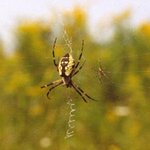Ecology & Zoology

Industrial agriculture faces painful challenges: the end of cheap energy, depleted water resources, impaired ecosystem services, and unstable climates. Scientists searching for alternatives to the highly specialized, energy intensive industrial system might profitably look to the biological synergies inherent in multi-species systems, according to an article in the March-April 2007 issue of Agronomy Journal. The paper's author, Fred Kirschenmann, Distinguished Fellow for Leopold Center for Sustainable Agriculture, Iowa State University, states that industrial agriculture assumes:
…

Plants have an immune system that resists infection, yet 10% of the world's agricultural production is lost annually to diseases caused by bacteria, fungi, and viruses. Understanding how disease resistance works may help combat this scourge.
In a new study published online this week in the open-access journal PLoS Biology, Tessa Burch-Smith, Savithramma Dinesh-Kumar, and colleagues show how one aspect of the plant immune system is defined by the gene-for-gene hypothesis: a plant Resistance (R) gene encodes a protein that specifically recognizes and protects against one pathogen or strain of…
The simultaneous effect of habitat fragmentation, overexploitation, and climate warming could accelerate the decline of populations and substantially increase their risk of extinction, a study published in the Proceedings of the Royal Society B has warned.
The viability of many marine and terrestrial species could be impaired due to interacting human activities that cause the loss of species' habitats, overexploitation of their populations and warming of their environments. Credit: Top left: John Veron from Corals of the World. Top right: Wolcott Henry/Marine Photobank, Bottom left: Steve…

Sometimes it is better to follow the advice of others rather than your own mind even though you seem to have things under control. Not only humans but also fish follow this doctrine as shown by ecologists Jörgen Johnsson and Fredrik Sundström of Göteborg University, Sweden, in the journal Ethology.
They allowed European minnows to learn the correct route through a maze to obtain food in the presence or absence of a predatory brown trout. Then a naïve minnow joined the group on later trials either in the presence or absence of the trout. Naïve fish without the predator were only half as…

Why are males larger than females in some animal species (such as most mammals), females larger than males in others (such as most insects), and why are the sexes alike in yet other species (such as several birds)? Further, how is such sexual size dimorphism achieved when it exists? If males and females grow at the same rate, then the larger sex has to extend its growth period. Alternatively, the larger sex can grow faster.
Argiope aurantia spiders. (Photograph by Matthias W. Foellmer)
A group of 13 researchers from 10 countries investigated the latter questions using comparative data on 155…

A male fish can size up potential rivals, and even rank them from strongest to weakest, simply by watching how they perform in territorial fights with other males, according to a new study by Stanford University scientists. The researchers say their discovery provides the first direct evidence that fish, like people, can use logical reasoning to figure out their place in the pecking order.
The study, published in the Jan. 25 edition of the journal Nature, is based on a unique experiment with cichlids (SIK-lids), small territorial fish from Africa. "In their natural habitat, male cichlids are…

Despite the icy cold and darkness, beneath the frozen surface of the sea in Antarctica thrives a rich and complex array of plants and animals. But what will happen to all those creatures if global warming reduces the ice-cover, as is predicted for coming decades?
UNSW marine ecologists Dr Emma Johnston and Graeme Clark have been working with the Australian Antarctic Division to survey marine communities along the striking coast of Wilkes Land, east Antarctica.
The stark beauty of Antarctica's ice hides a wealth of marine life. Copyright Graeme Clark UNSW.
It's now clear that ice plays a…

Carnivores are some of the widest ranging terrestrial mammals for their size, and this affects their energy intake and needs. This difference is also played out in the different hunting strategies of small and large carnivores. Smaller species less than 15-20 kg in weight specialize on very small vertebrates and invertebrates, which weigh a small fraction of their own weight, whereas larger species (>15-20 kg) specialize on large vertebrate prey near their own mass.
While carnivores around the size of a lynx or larger can obtain higher net energy intake by switching to relatively large…